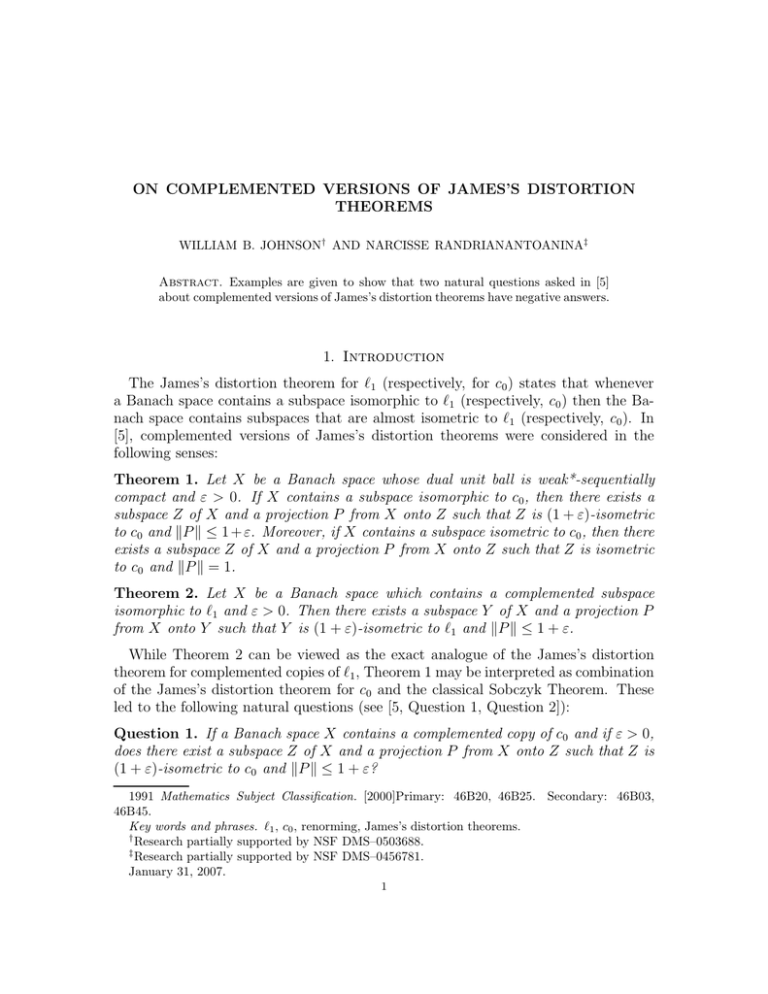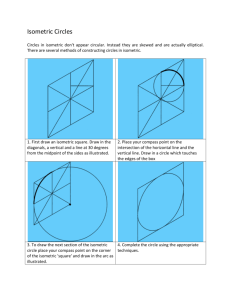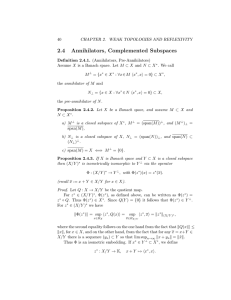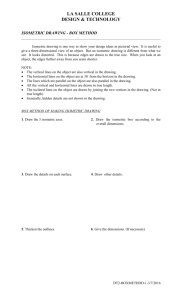ON COMPLEMENTED VERSIONS OF JAMES’S DISTORTION THEOREMS
advertisement

ON COMPLEMENTED VERSIONS OF JAMES’S DISTORTION THEOREMS WILLIAM B. JOHNSON† AND NARCISSE RANDRIANANTOANINA‡ Abstract. Examples are given to show that two natural questions asked in [5] about complemented versions of James’s distortion theorems have negative answers. 1. Introduction The James’s distortion theorem for 1 (respectively, for c0 ) states that whenever a Banach space contains a subspace isomorphic to 1 (respectively, c0 ) then the Banach space contains subspaces that are almost isometric to 1 (respectively, c0 ). In [5], complemented versions of James’s distortion theorems were considered in the following senses: Theorem 1. Let X be a Banach space whose dual unit ball is weak*-sequentially compact and ε > 0. If X contains a subspace isomorphic to c0 , then there exists a subspace Z of X and a projection P from X onto Z such that Z is (1 + ε)-isometric to c0 and P ≤ 1 + ε. Moreover, if X contains a subspace isometric to c0 , then there exists a subspace Z of X and a projection P from X onto Z such that Z is isometric to c0 and P = 1. Theorem 2. Let X be a Banach space which contains a complemented subspace isomorphic to 1 and ε > 0. Then there exists a subspace Y of X and a projection P from X onto Y such that Y is (1 + ε)-isometric to 1 and P ≤ 1 + ε. While Theorem 2 can be viewed as the exact analogue of the James’s distortion theorem for complemented copies of 1 , Theorem 1 may be interpreted as combination of the James’s distortion theorem for c0 and the classical Sobczyk Theorem. These led to the following natural questions (see [5, Question 1, Question 2]): Question 1. If a Banach space X contains a complemented copy of c0 and if ε > 0, does there exist a subspace Z of X and a projection P from X onto Z such that Z is (1 + ε)-isometric to c0 and P ≤ 1 + ε? 1991 Mathematics Subject Classification. [2000]Primary: 46B20, 46B25. Secondary: 46B03, 46B45. Key words and phrases. 1 , c0 , renorming, James’s distortion theorems. † Research partially supported by NSF DMS–0503688. ‡ Research partially supported by NSF DMS–0456781. January 31, 2007. 1 2 JOHNSON AND RANDRIANANTOANINA Question 2. If a Banach space X contains a complemented subspace isometric to 1 , does there exists a subspace Z of X and a projection P from X onto Z such that Z is isometric to 1 and P = 1? The aim of this note is to provide examples showing that, as expected, the answers to both questions are negative. 2. The examples 2.1. The c0 -case. In this subsection, we exhibit a Banach space X with the property that any complemented subspace of X that is almost isometric to c0 has large projection constant, thus answering Question 1 negatively. The space X is a renorming of ∞ ⊕∞ c0 . We denote by · the usual norm on ∞ ⊕∞ c0 . In order to define the new norm on X, let J : 1 → ∞ be an isometric embedding of 1 into ∞ and Q : 1 → c0 be a quotient map. For δ > 0, a norm ||| · ||| on X is defined by fixing its unit ball: B(X,|||·|||) := (Jf, Qf ); f ∈ 1 , f 1 ≤ 1 + δB(X,·) . It is clear that ||| · ||| and · are equivalent norms on X and X contains a complemented subspace isomorphic to c0 . Proposition 3. Let ε > 0 and Z be a subspace of (X, ||| · |||) that is (1 + ε)-isometric to c0 and is complemented in X. If P is a projection from X onto Z then |||P ||| ≥ 1+δ . 4δ(1 + ε)3 Proof. Throughout, we also denote by ||| · ||| the corresponding dual norm on X ∗ . Let (Vn )n≥1 be a basic sequence (1 + ε)-equivalent to the unit vector basis of c0 and whose closed linear span is Z. Let P be a projection from X onto Z. Then P is of the form ∞ Vn∗ ⊗ Vn P = n=1 (Vn∗ )n≥1 ∗ where is a weak -null sequence in X ∗ and the sum can be taken with respect to the strong operator topology. Observe that X ∗ = (∞ )∗ ⊕1 1 isomorphically and thus for every n ≥ 1, Vn∗ = (x∗n , a∗n ) where (x∗n )n≥1 (respectively, (a∗n )n≥1 ) is a weak∗ null sequence in (∞ )∗ (respectively, 1 ). Since weak∗ -null sequences are weakly-null in (∞ )∗ (see for instance [1, Theorem 15, p.103]), we have weak − lim x∗n = 0. n→∞ There exists a convex block (yn∗ )n≥1 of (x∗n )n≥1 with (2.1.1) lim yn∗ = 0. n→∞ JAMES’S DISTORTION 3 There exists a strictly increasing sequence of integers (kn )n≥0 and positive scalars n (n) (n) αj = 1 for n ≥ 1, and αj , where kn−1 + 1 ≤ j ≤ kn , kj=k n−1 +1 kn yn∗ = (n) αj x∗j . j=kn−1 +1 For n ≥ 1, consider the corresponding block sequences: Wn = kn Vj j=kn−1 +1 (2.1.2) Wn∗ = kn (n) αj Vj∗ j=kn−1 +1 Then (Wn )n≥1 is equivalent to the unit vector basis of c0 . Moreover, for every n, k ≥ 1, n (n) αj a∗j , and |||Wn ||| ≤ 1 + ε. Wn∗, Wk = δnk , Wn∗ = (yn∗ , b∗n ) where b∗n = kj=k n−1 +1 The latter implies that for n ≥ 1, Wn can be decomposed as (2.1.3) Wn = Jfn , Qfn + xn , an with (i) fn ∈ 1 satisfying fn 1 ≤ 1 + ε; (ii) (xn , an ) ≤ δ(1 + ε). Since (fn )n≥1 is a bounded sequence in 1 , we may assume (by passing to a subsequence if necessary) that for every n ≥ 1, fn = f0 + gn + hn where (a) (b) (c) (d) limn→∞ fn 1 exists; weak∗ − limn→∞ fn = f0 ; (gn )n≥1 is a disjointly supported sequence in 1 ; limn→∞ hn 1 = 0. We claim that (2.1.4) lim fn 1 ≤ 3δ(1 + ε). n→∞ 4 JOHNSON AND RANDRIANANTOANINA To see this claim, let N ≥ 1, then N N N 1 1 1 hn gn 1 + fn 1 ≤ f0 1 + 1 N n=1 N n=1 N n=1 N N 1 1 = f0 1 + gn 1 + hn 1 N n=1 N n=1 ≤ 2f0 1 + N N 1 2 hn . fn 1 + 1 N n=1 N n=1 N −1 Note that f0 1 ≤ lim N →∞ N −1 N n=1 fn 1 and limN →∞ N n=1 hn 1 = 0. We deduce that N 1 fn 1 . lim fn 1 ≤ 3 lim N →∞ n→∞ N n=1 We observe that N N 1 1 fn 1 = Jfn ∞ N n=1 N n=1 1 ≤ Jfn , Qfn N n=1 N N N 1 1 xn , an ≤ Wn + N n=1 N n=1 N 1 Wn + δ(1 + ε). ≤ N n=1 Since (Wn ) is equivalent to the unit vector basis of c0 , we have lim N N →∞ −1 N Wn = n=1 0. Combining all the above estimates, we get inequality (2.1.4). We now show that if Π is the projection from X onto the closed linear span of ∞ (Wn )n≥1 defined by Π = n=1 Wn∗ ⊗ Wn , then (2.1.5) |||Π||| ≥ 1+δ . 4δ(1 + ε)2 To see this, we first observe that for every y ∗ ∈ 1 , (2.1.6) |||(0, y ∗)||| = y ∗1 (1 + δ). JAMES’S DISTORTION 5 For every n ≥ 1, we have 1 = Wn∗ , Wn = yn∗ , b∗n , Jfn + xn , Qfn + an = yn∗ , Jfn + xn + b∗n , Qfn + an ≤ yn∗ + b∗n fn 1 + δ(1 + ε) . Taking limits as n → ∞, we deduce that (2.1.7) lim n→∞ b∗n 1 ≥ 1 . 4δ(1 + ε) We can estimate |||Π||| as follows: |||Wn∗||| n≥1 1 + ε |||(yn∗ , b∗n )||| = sup 1+ε n≥1 |||(yn∗ , b∗n )||| ≥ lim n→∞ 1+ε |||(0, b∗n )||| . = lim n→∞ 1+ε Thus (2.1.5) follows by combining (2.1.7) and (2.1.6). We conclude the proof by observing that |||Π||| ≤ (1 + ε)|||P |||. |||Π||| ≥ sup 2.2. The 1 -case. Now we provide an example showing that Theorem 2 does not extend to the isometric case. In particular, the answer to Question 2 is negative. First, recall that a norm · on a Banach space E is said to be strictly convex if Ext(BE ) = SE . This is equivalent to the following property (see for instance [6, p. 246]): (2.2.1) If x, y ∈ SE satisfy x + y = 2, then x = y. It is clear from (2.2.1) that if · is strictly convex then (E, · ) does not contain any 2∞ (the two dimensional ∞ ) isometrically. Indeed, if e1 = (1, 0) and e2 = (0, 1) are the unit vector basis of 2∞ then x = e1 and y = e1 + e2 fail to satisfy (2.2.1). Define a norm | · | on 1 that is equivalent to the usual norm and such that its dual norm | · |∗ is strictly convex. Such a dual norm on ∞ can be taken by setting: ∞ 1/2 2−i |ai |2 . |(ai )|∗ := (ai )2∞ + i=1 Details on the existence of the norm | · | can be found in [6, pp. 241–254]. We define a Banach space Y by setting: Y := (C[0, 1], · ∞ ) ⊕∞ (1 , | · |). 6 JOHNSON AND RANDRIANANTOANINA Proposition 4. The Banach space Y contains a complemented subspace that is isometric to 1 but 1 is not isometric to a quotient of Y . Let (en ) be the unit vector basis of 1 and for n ≥ 1, set vn := en /|en |. Fix a sequence (fn )n≥1 in C[0, 1] that is isometrically equivalent to the unit vector basis of 1 and for n ≥ 1, define Un := (fn , vn ) ∈ Y . We claim that (Un )n≥1 is isometrically equivalent to the unit vector basis of 1 and its closed linear span is complemented. In fact, for any finite sequence (an )n≥1 of scalars, |ai | = an fn ∞ n≥1 n≥1 ≤ an Un n≥1 ≤ Y |ai |, n≥1 therefore, n≥1 |ai | = n≥1 an Un Y . Moreover, if we denote by Z the closed linear span of (Un )n≥1 then Z is a complemented subspace of Y . Indeed, let T : (1 , |·|) → Y be defined by setting T (vn ) = Un for all n ≥ 1 and Π be the second projection from Y onto (1 , | · |) then T ◦ Π is a projection from Y onto Z. The fact that 1 is not isometric to a quotient of Y follows from the next lemma, which we assume is well known. Lemma 5. Let E and F be Banach spaces and T : c0 → E ⊕1 F be an isometry. Then there exists cj ≥ 0, j = 1, 2 with: (a) c1 + c2 = 1; (b) if T = (T1 , T2 ) then Tj (e) = cj e for j = 1, 2 and all e ∈ c0 . In particular, if E ⊕1 F contains an isometric copy of c0 then either E or F contains an isometric copy of c0 . Proof. Denote by c00 the space of finitely supported sequences of scalars and let (en )n≥1 be the unit vector basis of c0 . Write T = (T1 , T2 ) with T1 : c0 → E and T2 : c0 → F . We shall verify that for every x ∈ c00 with x = 1, Tj (x) = Tj (e1 ) for j = 1, 2. To see this, we will show first that if x and y are disjointly supported unit vectors then (2.2.2) Tj (x) = Tj (y) for j = 1, 2. Write 2x = (x − y) + (x + y). Then 2 = T (2x) = T1 (2x) + T2 (2x) ≤ (T1 (x − y) + T1 (x + y)) + (T2 (x − y) + T2 (x + y)) = T (x − y) + T (x + y) = 2. JAMES’S DISTORTION 7 For j = 1, 2, set aj = Tj (x − y) + Tj (x + y) − 2Tj (x). Then (a1 , a2 ) is a positive element of 21 whose norm is equal to zero so 2Tj (x) = Tj (x − y) + Tj (x + y), j = 1, 2. By reversing the role of x and y, we get (2.2.2). Now, let x ∈ c00 with x = 1. Choose, n > 1 so that en and x are disjointly supported. From (2.2.2), Tj (x) = Tj (en ) = Tj (e1 ), j = 1, 2. Setting cj = Tj (e1 ) for j = 1, 2 proves the lemma. End of the proof of Proposition 4. If 1 is isometric to a quotient of Y then the dual space Y ∗ = C[0, 1]∗ ⊕1 (∞ , | · |∗ ) contains an isometric copy of ∞ = ∗1 and hence of c0 . But since | · |∗ is strictly convex and C[0, 1]∗ is a L1 -space, this is in contradiction with Lemma 5 and thus completes the proof. 3. Concluding remarks The notion of asymptotically isometric copies of 1 (respectively, c0 ) is closely related to James’s distortion theorems. We recall that a Banach space E is said to contain an asymptotically isometric copy of 1 (respectively, c0 ) if there exist a null sequence (εn )n≥1 in (0, 1) and a sequence (xn )n≥1 in E such that for all finite sequence (tn )n of scalars: (1 − εn )|tn | ≤ tn xn ≤ |tn |, n respectively, n n tn xn ≤ sup |tn |, sup(1 − εn )|tn | ≤ n n n The norm introduced in the definition of the Banach space Y can be used to provide examples confirming the optimality of the James’s distortion theorems. We refer to [4] for earlier examples. Proposition 6. (a) (1 , | · |) does not contain any subspace asymptotically isometric to 1 . (b) (∞ , | · |∗ ) does not contain any subspace asymptotically isometric to c0 . Proof. These statements follow from the norm | · |∗ being strictly convex and some known results. First, containing an asymptotically isometric copy of c0 and containing an isometric copy of c0 is equivalent in a dual space ([3]). Second, according to [2], a Banach space contains an asymptotically isometric copy of 1 if and only if its dual contains an isometric copy of L1 [0, 1]. But since (∞ , | · |∗ ) is strictly convex, it does not contain any isometric copy of 1 and therefore it can not contain any isometric copy of L1 [0, 1]. Part (a) was already observed in [2] where an explicit formula for | · | was given (see [2, Corollary 12]). 8 JOHNSON AND RANDRIANANTOANINA The proof of Proposition 4 yields that the last part of the conclusion of Proposition 4 can be strengthened to “c0 is not isometric to a subspace of Y ∗ ”. However, in [3] Dowling proved that 1 is a quotient of X if and only if c0 embeds isometrically into X ∗ , so the more natural statement involving 1 is only formally weaker. References [1] J. Diestel, Sequences and series in Banach spaces, Graduate Text in Mathematics, 92, SpringerVerlag, New York, 1984. MR 85i:46020 [2] S. Dilworth, M. Girardi, and J. Hagler, Dual Banach spaces which contain an isometric copy of L1 , Bull. Polish Acad. Sci. Math. 48 (2000), 1–12. MR 2001e:46016 [3] P. N. Dowling, Isometric copies of c0 and l∞ in duals of Banach spaces, J. Math. Anal. Appl. 244 (2000), no. 1, 223–227. MR 2000m:46036 [4] P. N. Dowling, W. B. Johnson, C. J. Lennard, and B. Turett, The optimality of James’s distortion theorems, Proc. Amer. Math. Soc. 125 (1997), no. 1, 167–174. MR 97d:46010 [5] P. N. Dowling, N. Randrianantoanina, and B. Turett, Remarks on James’s distortion theorems. II, Bull. Austral. Math. Soc. 59 (1999), no. 3, 515–522. MR 2000c:46022 [6] M. Fabian, P. Habala, P. Hájek, V. Montesinos Santalucı́a, J. Pelant, and V. Zizler, Functional analysis and infinite-dimensional geometry, CMS Books in Mathematics/Ouvrages de Mathématiques de la SMC, 8, Springer-Verlag, New York, 2001. MR 2002f:46001 Department of Mathematics, Texas A&M University, College Station, TX 77843 E-mail address: johnson@math.tamu.edu Department of Mathematics and Statistics, Miami University, Oxford, OH 45056 E-mail address: randrin@muohio.edu







